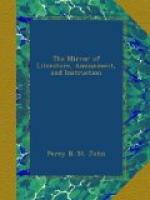(Called Taxus, probably from the Greek, which signifies swiftness, and may allude to the velocity of an arrow shot from a yew-tree bow,) is a tree of no little celebrity, both in the military and the superstitious history of England. The common yew is a native of Europe, of North America, and of the Japanese Isles. It used to be very plentiful in England and Ireland, and probably also Scotland. Caesar mentions it as having been abundant in Gaul; and much of it is found in Ireland, imbedded in the earth. The trunk and branches grow very straight; the bark is cast annually; and the wood is compact, hard, and very elastic. It is therefore of great use in every branch of the arts in which firm and durable timber is required; and, before the general use of fire-arms, it was in high request for bows: so much of it was required for the latter purpose, that ships trading to Venice were obliged to bring ten bow staves along with every butt of Malmsey. The yew was also consecrated—a large tree, or more being in every churchyard; and they were held sacred.[3] In funeral processions the branches were carried over the dead by mourners, and thrown under the coffin in the grave. The following extract from the ancient laws of Wales will show the value that was there set upon these trees, and also how the consecrated yew of the priests had risen in value over the reputed sacred mistletoe of the Druids:—
“A consecrated yew, its value is a pound.
“A misletoe branch, threescore pence.
“An oak, sixscore pence.
“Principal branch of an oak, thirty pence.
“A yew tree, (not consecrated) fifteen pence.
“A sweet apple, threescore pence.
“A sour apple, thirty pence.
“A thorn-tree, seven pence halfpenny. Every tree after that, fourpence.”
[3] Yew trees—those
gloomy tenants of our churchyards—appear
to
have
been planted there in ancient times. In the will
of Henry
VI.
there is the following item:—“The
space between the wall
of
the church and the wall of the cloyster shall conteyne
38
feyte,
which is left for to sett in certayne trees and flowers,
behovable
and convenient for the custom of the said church.”
Several
reasons may be assigned for giving this tree a preference
to
every other evergreen. It is very hardy, long-lived,
and,
though
in time it attains a considerable height, produces
branches
in abundance, so low as to be always within reach
of
the hand, and at last affords a beautiful wood for
furniture.—The
date of the yews at Bedfont is 1704.




